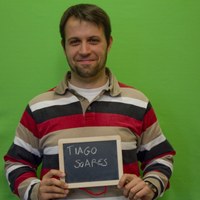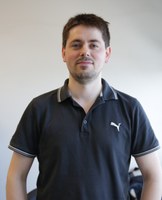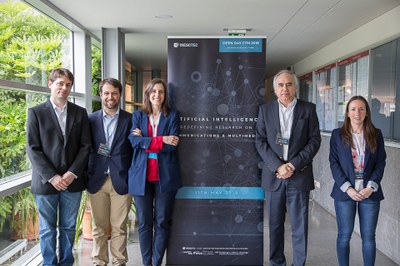Limelight
In a universe of more than 1200 collaborators, there are many months when there is more than one collaborator with a performance suitable for “Limelight”. An example of this is the fact that for several months we receive more than one nominee. This led to a change in the publication policy: BIP has started to highlight all nominees, without considering the merit (because all nominees have much merit!). Additionally, considering the criteria for news opportunity, an interview with one of the nominees is developed.
This month we spoke with Nuno Almeida, Joana Tavares, PEdro SIlva and Tiago Costa (CTM)
1. How did your journey brought you to INESC TEC/CTM?
TC: In my case in particular, after I completed my Master in Computer Engineering from ISEP in 2009 and after spending some time in the industry in the following year, I decided to invest in Research, which had already aroused my interest during my Master thesis. The Recoop project, which is out of my comfort zone due to it being focused on Telecommunication Networks, was my gateway to CTM (back then known as UTM) in the end of 2010. Since then, I collaborated in several national and international projects, providing my expertise in the Multimedia, Networks and Energy fields. In 2016, I began my PhD in Computer Engineering at a time in which it made sense to further develop the knowledge I gained over several years of Research at INESC TEC/CTM.

[Tiago Costa]
JT: The first contact I had with INESC TEC was in 2012 and it was here that I developed my Master thesis as a student of FEUP in the Integrated Master in Electrical and Computers Engineering. Some of the results achieved through this work about the theme of radio over fibre, were present in two international publications, thus leaving the door open for research. In 2014, I ended up following the path of research by receiving a scholarship to the TWave project, a joint project between INESC TEC and the IT of Aveiro. A year later, with more experience and knowledge, I decided to apply for the Doctoral Programme in Telecommunications (MAP-tele) which I am currently attending, besides participating in the H2020 iBrow project.
PS: My first contact with INESC TEC was in 2008 under the DR-VIDS project. I was still a student from the Master in Informatics and Computing Engineering (MIEIC) of FEUP. In 2009, after I completed the MIEIC, I started to collaborate in the SWIOP project and in the following year, I began my PhD, which I completed last year. Currently, I am a Visiting Professor at FEUP.

[Nuno Almeida]
NA: Well, in my case we need to go back to 1985. At that time, INESC-Norte (the name used at the time) was starting its activities here in Porto, recruiting newly graduated students for their first research projects. Since I took my degree in Electrotechnical Engineering (Telecommunications area), the fact that I was able to continue my research was very attractive and so I entered into INESC. At that time, CTM didn’t exist (nor did UTM) but the involvement in the R&D activities in telecommunications exists since then, having participated actively in the SIFO project (1985-1988).
2. Joana and Tiago are currently attending the PhD as researchers of CTM. How are these realities combined?
TC: It is a very important aspect since both these roles pose challenges and different motivations. Each research project has its needs and specific goals, which are not always compatible with the aims we set for our PhD, especially if it is linked to technology fields that are completely different. However, there is the “know-how” acquired in several areas (machine learning, for example) that is directly applicable both to research and to PhD. The main difficulty arise from the time management required for each one of these roles in order to develop an excellent job, which inevitably forces to be flexible to succeed.

[Joana Tavares]
JT: In fact, I believe there is a connection between both realities. In my case in particular, it was the presentation of ongoing projects at CTM that made possible to progress in my PhD. On the one hand, I helped in the development of projects in which I participated and, on the other hand, those same projects helped in the development of my PhD, thus establishing a symbiosis between these two realities.
3. Pedro and Nuno are Professors at FEUP. How is it to develop your research areas at INESC TEC?
PS: Teaching is a recent activity for me, for that reason my main challenge has been to figure out how to combine that with research. Besides that, as I am now a PhD researcher, the role to play in the research activities has also changed a bit. With so many changes in less than a year, I am still in the adjustment process.

[Pedro Silva]
NA: It’s not always easy. In fact, in terms of time schedule, there are times where my commitments related to teaching (classes, exams and tests) and those related to research projects/activities don't combine with each other. However, in any case, the most important aspect for the development of research areas is the fact that INESC TEC provides a technical and scientific environment where it is possible to have more brainstorming and discussions. As a consequence, this almost always results in synergies that favour the development of areas and foster the emergence of new research lines. Both FEUP and INESC TEC benefit from this interaction.

4. The nomination is done under the Open Day of CTM, which is in its third edition. How and when did this work started?
NA: This work started almost a year ago when I was invited to lead the organising committee (at the end of July of 2017). Since then, and according to the skills that were necessary, we first thought on the composition of the team and as such Pedro Silva (WiN), Tiago Costa (MCT) and Joana Tavares (OET) were invited to be a part of it. They generously accepted the invite in order to belong to the organising team, the first meeting being in early October. After that, it was more than half a year of constant activity, almost always with fortnightly meetings in order to reflect, discuss, plan and execute all the necessary steps leading to the organisation of the event.

5. We will end this interview by asking you to comment on your nomination by the CTM Coordination:
“The CTM Coordination nominates the organising committee of the Open Day CTM 2018, composed of Joana Tavares, Pedro Silva, Tiago Costa and led by Professor Nuno Almeida for Limelight”. Nuno Almeida: The event organised by this team attracted a high number of participants. It was carried out in an exemplary manner and fostered an opportune moment for reflection on the artificial intelligence applied to telecommunications and multimedia.”
NA: Believing that I can share all the feelings of the team, I think this nomination will be very flattering for us. In fact, although it was both an honour and a responsibility to belong to the organising committee of the Open Day, we probably didn’t meet more than the natural expectations for the event, which are also increasing year after year. Nevertheless, we obviously are very proud and grateful for this distinction. We are also very pleased to know that the theme discussed (artificial intelligence applied to telecommunications and multimedia) was highly valued by the participants, thus contributing to a bigger interest over the current (and future) research areas of CTM.
In conclusion, it is essential to mention that the success of the Open Day CTM 2018 was due to many other people. In this way, we would like to take this opportunity to thank all the collaboration of the CTM elements (especially to the coordination, to the people who were involved in the demonstrators and the secretariat), the communication service (SCOM), the keynote speaker, the moderator, the elements from the panel discussion, as well as all the other participants of the event, without whom this achievement would not be possible. Thank you all.


